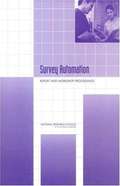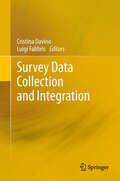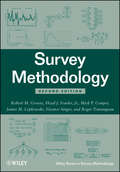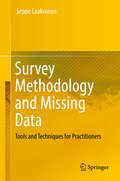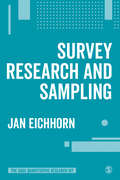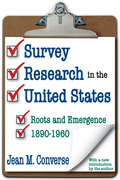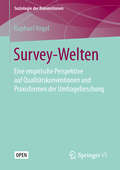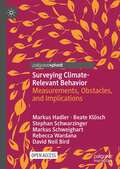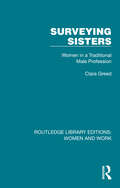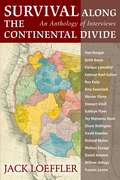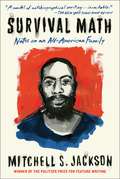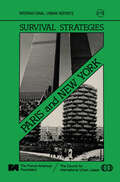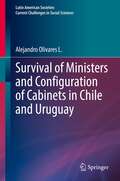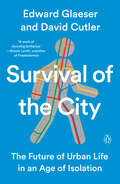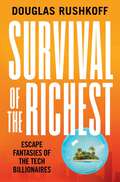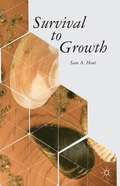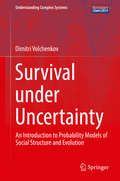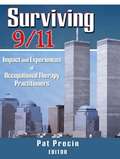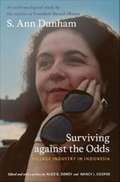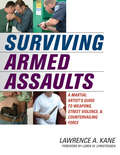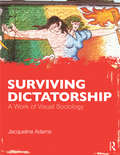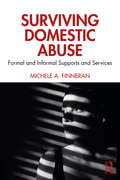- Table View
- List View
Survey Automation: Report and Workshop Proceedings
by Oversight Committee for the Workshop on Survey AutomationFor over 100 years, the evolution of modern survey methodology—using the theory of representative sampling to make interferences from a part of the population to the whole—has been paralleled by a drive toward automation, harnessing technology and computerization to make parts of the survey process easier, faster, and better. The availability of portable computers in the late 1980s ushered in computer-assisted personal interviewing (CAPI), in which interviewers administer a survey instrument to respondents using a computerized version of the questionnaire on a portable laptop computer. Computer assisted interviewing (CAI) methods have proven to be extremely useful and beneficial in survey administration. However, the practical problems encountered in documentation and testing CAI instruments suggest that this is an opportune time to reexamine not only the process of developing CAI instruments but also the future directions of survey automation writ large.
Survey Data Collection and Integration
by Cristina Davino Luigi FabbrisStatistical surveys represent an important source of scientific knowledge and a valid decision support tool in many fields, from social studies to economics, market research, health studies, and others. Scientists have tackled most of the methodological issues concerning surveys and the scientific literature offers excellent proposals for planning and conducting surveys. Nevertheless, surveys often require the achievement of aims that either deviate from the methodology or do not have a specific solution at all. This book focuses on survey theory and applications, providing insight and innovative solutions to face problems in data collection and integration, complex sample design, opinion questionnaire design, and statistical estimation. Formal rigour and simple language, together with real-life examples, will make the book suitable to both practitioners involved in applied research and to academics interested in scientific developments in the survey field.
Survey Methodology
by Floyd J. Fowler Jr. Eleanor Singer James M. Lepkowski Roger Tourangeau Robert M. Groves Mick P. CouperThis new edition of Survey Methodology continues to provide a state-of-the-science presentation of essential survey methodology topics and techniques. The volume's six world-renowned authors have updated this Second Edition to present newly emerging approaches to survey research and provide more comprehensive coverage of the major considerations in designing and conducting a sample survey.Key topics in survey methodology are clearly explained in the book's chapters, with coverage including sampling frame evaluation, sample design, development of questionnaires, evaluation of questions, alternative modes of data collection, interviewing, nonresponse, post-collection processing of survey data, and practices for maintaining scientific integrity. Acknowledging the growing advances in research and technology, the Second Edition features: Updated explanations of sampling frame issues for mobile telephone and web surveys. New scientific insight on the relationship between nonresponse rates and nonresponse errors. Restructured discussion of ethical issues in survey research, emphasizing the growing research results on privacy, informed consent, and confidentiality issues. The latest research findings on effective questionnaire development techniques. The addition of 50% more exercises at the end of each chapter, illustrating basic principles of survey design. An expanded FAQ chapter that addresses the concerns that accompany newly established methods. Providing valuable and informative perspectives on the most modern methods in the field, Survey Methodology, Second Edition is an ideal book for survey research courses at the upper-undergraduate and graduate levels. It is also an indispensable reference for practicing survey methodologists and any professional who employs survey research methods.
Survey Methodology and Missing Data: Tools and Techniques for Practitioners
by Seppo LaaksonenThis book focuses on quantitative survey methodology, data collection and cleaning methods. Providing starting tools for using and analyzing a file once a survey has been conducted, it addresses fields as diverse as advanced weighting, editing, and imputation, which are not well-covered in corresponding survey books. Moreover, it presents numerous empirical examples from the author's extensive research experience, particularly real data sets from multinational surveys.
Survey Research and Sampling (The SAGE Quantitative Research Kit)
by Jan EichhornThis book is an ideal companion for students looking to undertake survey research. Anchored by lots of case studies of real research and expert interviews to strengthen your understanding, it provides guidance on: Selecting the best sampling method for your research Designing questionnaires to ensure you gather valuable data Collecting your data to represent populations well Piloting questionnaires to ensure quality research Part of The SAGE Quantitative Research Kit, this book will give you the know-how and confidence needed to succeed on your quantitative research journey
Survey Research and Sampling (The SAGE Quantitative Research Kit)
by Jan EichhornThis book is an ideal companion for students looking to undertake survey research. Anchored by lots of case studies of real research and expert interviews to strengthen your understanding, it provides guidance on: Selecting the best sampling method for your research Designing questionnaires to ensure you gather valuable data Collecting your data to represent populations well Piloting questionnaires to ensure quality research Part of The SAGE Quantitative Research Kit, this book will give you the know-how and confidence needed to succeed on your quantitative research journey
Survey Research in the United States: Roots and Emergence 1890-1960
by Jean M. ConverseHardly an American today escapes being polled or surveyed or sampled. In this illuminating history, Jean Converse shows how survey research came to be perhaps the single most important development in twentieth-century social science. Everyone interested in survey methods and public opinion, including social scientists in many fi elds, will find this volume a major resource.Converse traces the beginnings of survey research in the practical worlds of politics and business, where elite groups sought information so as to infl uence mass democratic publics and markets. During the Depression and World War II, the federal government played a major role in developing surveys on a national scale. In the 1940s certain key individuals with academic connections and experience in polling, business, or government research brought surveys into academic life. By the 1960s, what was initially viewed with suspicion had achieved a measure of scientific acceptance of survey research.The author draws upon a wealth of material in archives, interviews, and published work to trace the origins of the early organizations (the Bureau of Applied Social Research, the National Opinion Research Center, and the Survey Research Center of Michigan), and to capture the perspectives of front-line fi gures such as Paul Lazarsfeld, George Gallup, Elmo Roper, and Rensis Likert. She writes with sensitivity and style, revealing how academic survey research, along with its commercial and political cousins, came of age in the United States.
Survey-Welten: Eine empirische Perspektive auf Qualitätskonventionen und Praxisformen der Umfrageforschung (Soziologie der Konventionen)
by Raphael VogelDie Open-Access-Studie nimmt eine plurale Perspektive auf Survey-Qualität ein und untersucht empirisch unterschiedliche Logiken der Survey-Produktion. Wie aufgezeigt wird, gehen die vier identifizierten Survey-Welten mit unterschiedlichen Koordinationsprozessen und Qualitätskonventionen einher. Survey-Qualität wird dabei auf einer pragmatischen Basis im Hinblick auf unterschiedliche Nutzungskontexte von statistischen Daten konzipiert. Durch die Verknüpfung der Qualitätsthematik mit der praktischen Organisation des Produktionsprozesses von surveybasierten Daten wird eine engere Verbindung zwischen den Arbeiten der normativen Survey-Methodologie und den Herausforderungen der empirischen Survey-Praxis angestrebt. Die Arbeit präsentiert die Pluralität der Praxisformen von Umfragen, sie identifiziert die Vielfalt der Qualitätskriterien und sie leistet eine konzeptionelle Grundlage für reflexives Survey-Management.Der InhaltPerspektiven auf Survey-Qualität ● Die erweiterte Perspektive der Economie des conventions ● Methodologische Grundlegung und methodisches Vorgehen ● Die vier Survey-Welten im Überblick ● Survey-Projekte aus einer survey-weltlichen Perspektive ● Eine vertiefte survey-weltliche Perspektive auf Surveys ● Skizze einer Systematisierung von Relationen zwischen Regimen des Engagements und Rechtfertigungsordnungen Der Autor Dr. Raphael Vogel war bis Juni 2018 Mitarbeiter am Soziologischen Seminar der Universität Luzern.
Surveying Christian Beliefs and Religious Debates in Post-War Britain
by B. ClementsClements provides a detailed study of religious beliefs in British society, using a broad range of opinion poll and social survey data. Examining public opinion on religious-secular issues, this book provides a rich analysis of the belief and attitudes of social groups over time.
Surveying Christian Beliefs and Religious Debates in Post-War Britain
by Ben ClementsSurveying Christian Beliefs and Religious Debates in Post-War Britain.
Surveying Climate-Relevant Behavior: Measurements, Obstacles, and Implications
by Markus Hadler Beate Klösch Stephan Schwarzinger Markus Schweighart Rebecca Wardana David Neil BirdThis open access book discusses the contribution of sociology and survey research to climate research. The authors address the questions of which behaviors are of climate relevance, who is engaging in these behaviors, in which contexts do these behaviors occur, and which individual perceptions and values are related to them. Utilizing survey research, the book focuses on the measurement of climate-relevant behaviors with population surveys and develops an instrument that allows a valid estimate of an individual’s GHG emissions with a few core items. While the development of these instruments was based on surveys and qualitative interviews conducted in Austria, the instruments were subsequently tested in a set of 31 European countries, revealing the international relevance of such research. The book also concludes with a brief consideration of the effects of the COVID-19 crisis on environmental attitudes, situating the project globally.
Surveying Sisters: Women in a Traditional Male Profession (Routledge Library Editions: Women and Work)
by Clara GreedOver the past few years there had been a dramatic increase in the number of women entering the surveying profession. Fewer than five per cent of practising surveyors were women, but women comprised twenty per cent of students. Originally published in 1991, Surveying Sisters explores the question of whether ‘more’ would mean ‘better’, either for women surveyors themselves, or for women as consumers of the built environment. Clara Greed investigates the experiences of individual women surveyors, as well as studying the nature of the male majority. Taking a broadly feminist perspective and using an ethnographic approach, she develops a strong theoretical basis, incorporating the gender, class, and spatial dimensions of the situation, centring round the concept that surveying has its own distinct professional subculture. She traces the historical roots of the profession, and its attitudes to women, and makes constructive suggestions for improving the position of women surveying today. This was a highly topical study, at a time when the surveying profession was eager to attract more women in order to allay the effects of declining numbers of school leavers and potential ‘manpower’ shortages. It will be of interest to people concerned about issues of gender in disciplines such as sociology, management studies, higher education, urban geography, and women’s studies, and to the women and men who work in the surveying and other built environment professions.
Survival Along the Continental Divide: An Anthology of Interviews
by Jack LoefflerFor over forty years aural historian Jack Loeffler has wandered the West engaging people in conversations and recording those conversations for posterity. When asked by the New Mexico Humanities Council to produce an anthology of interviews that would combine elements of two projects sponsored by the Council, the Between Fences traveling exhibition and a project focused on the Great Depression and New Deal, Loeffler turned to the landscape of the Continental Divide and the diverse cultures that inhabit both sides of its arid terrain.Hopi, Navajo, Rio Grande Puebloan, Hispano, and Anglo cultures are represented in three sections of interviews that respectively address shifting cultural boundaries, explore the effects in New Mexico of the New Deal's attempts to reinvigorate the economy and mainstream American culture, and suggest ways of delving into the difficult situations that face the West today. Together, these diverse perspectives reveal the rich cultural mosaic that has evolved in this extraordinary landscape.
Survival Math: Notes on an All-American Family
by Mitchell JacksonAn electrifying, dazzlingly written reckoning and an essential addition to the national conversation about race and class, Survival Math takes its name from the calculations award-winning author Mitchell S. Jackson made to survive the Portland, Oregon of his youth. <P><P>This dynamic book explores gangs and guns, near-death experiences, sex work, masculinity, composite fathers, the concept of “hustle,” and the destructive power of addiction—all framed within the story of Jackson, his family, and his community. Lauded for its breathtaking pace, its tender portrayals, its stark candor, and its luminous style, Survival Math reveals on every page the searching intellect and originality of its author. <P><P>The primary narrative, focused on understanding the antecedents of Jackson’s family’s experience, is complemented by poems composed from historical American documents as well as survivor files, which feature photographs and riveting short narratives of several of Jackson’s male relatives. <P><P>The sum of Survival Math’s parts is a highly original whole, one that reflects on the exigencies—over generations—that have shaped the lives of so many disenfranchised Americans. As essential as it is beautiful, as real as it is artful, Mitchell S. Jackson’s nonfiction debut is a singular achievement, not to be missed.
Survival Strategies: Paris and New York: Conference on Two World Cities: Papers
by George G. WynneFirst published 1979, this is a most unusual contribution to comparative urban systems. It examines Paris and New York in terms of future prospects for each city in the face of draconian social, economic, and political changes, and takes as axiomatic that the struggles of New York and Paris are those of super cities: namely struggles to survive as world centers and not just as national metropolitan areas of worth. The volume covers such vital areas as planning for older cities like Paris and New York, problems in the internal management system of each city, the relationship between inner cities and suburbs, and issues involved in regional planning in which the two world cities provide models for their nations and the world as a whole.The work is unusual in that it not only appraises organizational issues, but sociological and architectural ones as well. Hence, the issue of blacks in New York, or Arabs in Paris, is addressed with considerable candor and insight. The relationship between substandard housing in each of the cities is examined with the clear understanding of the racial dynamics at work in each of these centers.This work gives intellectual and practical substance to Gottman's notion of megalopolis, and places in sharp comparative relief problems which all too often are seen as local and parochial in character. This volume represents the first world-cities approach to real world cities, and as such, is a pioneering effort that will be greeted with great enthusiasm by scholarly and general readers alike. The authors gathered for this effort represent leading practitioners from both France and the United States, and hence the volume is a joy to read no less than to ponder.
Survival of Ministers and Configuration of Cabinets in Chile and Uruguay (Latin American Societies)
by Alejandro Olivares L.This book develops an analysis of ministerial recruitment in the process of government formation, the process of dismissal, and survival of cabinet ministers in Chile and Uruguay. The two cases are countries that, generally, score the highest democracy indexes in Latin America, but also, they are considered as the most stable presidential systems in the Southern Cone of the region, allowing readers to compare within and between cases. The cases analyzed in this book are small countries with a similar history of democratic breakdowns which, in temporal terms, enable comparison. Additionally, given the reasons that triggered those processes, both cases are normally studied together. For pre-coup democracy, the cases include the governments of Chile between 1933 and 1973 and Uruguay between 1943 and 1973. This research does not analyze the military coup regime in either country. Thus, the period is resumed in the democratic transitions for both cases, i.e., 1985 for Uruguay and 1990 for Chile. Although literature on ministerial cabinets survival usually focus on parliamentary regimes from the Global North, this rather new phenomenon in presidential democracies has quickly gained academic notoriety. Research on cabinets and ministers in Latin American presidential systems tends to focus on the periods beginning with the return to democracy after the 1980s. This situation means that there is scant knowledge of the period prior to the coups. By presenting an in-depth study of two presidential systems from the Global South, Survival of Ministers and Configuration of Cabinets in Chile and Uruguay, will be a useful resource for political and social scientists willing to study cabinet formation and ministerial turnover in Latin America, whether is on case-study research or in a comparative perspective.
Survival of the City: Living and Thriving in an Age of Isolation
by David Cutler Edward GlaeserOne of our great urbanists and one of our great public health experts join forces to reckon with how cities are changing in the face of existential threats the pandemic has only accelerated Cities can make us sick. They always have—diseases spread more easily when more people are close to one another. And disease is hardly the only ill that accompanies urban density. Cities have been demonized as breeding grounds for vice and crime from Sodom and Gomorrah on. But cities have flourished nonetheless because they are humanity&’s greatest invention, indispensable engines for creativity, innovation, wealth, and connection, the loom on which the fabric of civilization is woven. But cities now stand at a crossroads. During the global COVID crisis, cities grew silent as people worked from home—if they could work at all. The normal forms of socializing ground to a halt. How permanent are these changes? Advances in digital technology mean that many people can opt out of city life as never before. Will they? Are we on the brink of a post-urban world? City life will survive but individual cities face terrible risks, argue Edward Glaeser and David Cutler, and a wave of urban failure would be absolutely disastrous. In terms of intimacy and inspiration, nothing can replace what cities offer. Great cities have always demanded great management, and our current crisis has exposed fearful gaps in our capacity for good governance. It is possible to drive a city into the ground, pandemic or not. Glaeser and Cutler examine the evolution that is already happening, and describe the possible futures that lie before us: What will distinguish the cities that will flourish from the ones that won&’t? In America, they argue, deep inequities in health care and education are a particular blight on the future of our cities; solving them will be the difference between our collective good health and a downward spiral to a much darker place.
Survival of the Richest: Escape Fantasies of the Tech Billionaires
by Douglas RushkoffThe tech elite have a plan to survive the apocalypse: they want to leave us all behind. Five mysterious billionaires summoned Douglas Rushkoff to a desert resort for a private talk. The topic? How to survive The Event: the societal catastrophe they know is coming. Rushkoff came to understand that these men were under the influence of The Mindset, a Silicon Valley–style certainty that they can break the laws of physics, economics, and morality to escape a disaster of their own making—as long as they have enough money and the right technology. In Survival of the Richest, Rushkoff traces the origins of The Mindset in science and technology through its current expression in missions to Mars, island bunkers, and the Metaverse. This mind-blowing work of social analysis shows us how to transcend the landscape The Mindset created—a world alive with algorithms and intelligences actively rewarding our most selfish tendencies—and rediscover community, mutual aid, and human interdependency. Instead of changing the people, he argues, we can change the program.
Survival to Growth
by Sam A. HoutSurvival to Growth explores human nature and illustrates how occupational goals and objectives can be achieved by applying a basic organizational approach while upgrading the skill level of each company employee.
Survival under Uncertainty
by Dimitri VolchenkovThis book introduces and studies a number of stochastic models of subsistence, communication, social evolution and political transition that will allow the reader to grasp the role of uncertainty as a fundamental property of our irreversible world. At the same time, it aims to bring about a more interdisciplinary and quantitative approach across very diverse fields of research in the humanities and social sciences. Through the examples treated in this work - including anthropology, demography, migration, geopolitics, management, and bioecology, among other things - evidence is gathered to show that volatile environments may change the rules of the evolutionary selection and dynamics of any social system, creating a situation of adaptive uncertainty, in particular, whenever the rate of change of the environment exceeds the rate of adaptation. Last but not least, it is hoped that this book will contribute to the understanding that inherent randomness can also be a great opportunity - for social systems and individuals alike - to help face the challenge of "survival under uncertainty".
Surviving 9/11: Impact and Experiences of Occupational Therapy Practitioners
by Pat PrecinThe first in-depth look of the effects of September 11 on occupational therapy! Surviving 9/11: Impact and Experiences of Occupational Therapy Practitioners is a collection of firsthand accounts from occupational therapy providers and their clients. This book reveals the thoughts and fears of occupational therapists who had to help heal their patients while suffering emotional and psychological stress themselves. This volume shows how occupational therapy practitioners dealt with the aftermath using group discussions, planned events, and creative projects to heal themselves as well as their clients. Surviving 9/11 demonstrates the importance of therapeutic treatment for all types of victims of the attacks, from survivors to television observers. It discusses how distinct each client&’s needs are-from the survivor in the hospital bed to the firefighter endlessly searching for his lost brothers. This book will also show you the importance of changing therapeutic styles during the lengthy coping process to adapt to the changing needs of the client. This enlightening text is divided into three parts: September 11th Day One-personal and professional accounts of the day of the disaster from occupational therapists in and around the city and around the world-with a special narrative from a 9/11 survivor who received occupational therapy Ground Zero Milieu-the experiences in and around Ground Zero following the attack, including occupational therapists at the rescue and recovery site, the Federal Emergency Management Agency&’s (FEMA) Project Liberty program, and the development of the Downtown Therapists Assistance Project to help occupational and physical therapists whose businesses were irrecoverable after September 11 Spirituality-the new challenges to occupational therapy in mental health in dealing with post-traumatic stress disorder and panic disorder-throughout the general population and in the mental health community Surviving 9/11 is a unique blend of personal and professional perspectives designed to help you get in touch with your feelings and thoughts about what happened on September 11. More importantly, this easy-to-read book can help you prepare for future disasters, whether you are a healthcare professional, a disabled person, a survivor, or someone who is otherwise affected. With illustrations, memorial designs, and photos of the tragedy and its aftermath, this book is a must-read in this age of uncertainty.
Surviving Against the Odds: Village Industry in Indonesia
by S. Ann DunhamRead the foreword by Mara Soetoro-Ng President Barack Obama's mother, S. Ann Dunham, was an economic anthropologist and rural development consultant who worked in several countries including Indonesia. Dunham received her doctorate in 1992. She died in 1995, at the age of 52, before having the opportunity to revise her dissertation for publication, as she had planned. Dunham's dissertation adviser Alice G. Dewey and her fellow graduate student Nancy I. Cooper undertook the revisions at the request of Dunham's daughter, Maya Soetoro-Ng. The result is Surviving against the Odds, a book based on Dunham's research over a period of fourteen years among the rural metalworkers of Java, the island home to nearly half Indonesia's population. Surviving against the Odds reflects Dunham's commitment to helping small-scale village industries survive; her pragmatic, non-ideological approach to research and problem solving; and her impressive command of history, economic data, and development policy. Along with photographs of Dunham, the book includes many pictures taken by her in Indonesia. After Dunham married Lolo Soetoro in 1967, she and her six-year-old son, Barack Obama, moved from Hawai'i to Soetoro's home in Jakarta, where Maya Soetoro was born three years later. Barack returned to Hawai'i to attend school in 1971. Dedicated to Dunham's mother Madelyn, her adviser Alice, and "Barack and Maya, who seldom complained when their mother was in the field," Surviving against the Odds centers on the metalworking industries in the Javanese village of Kajar. Focusing attention on the small rural industries overlooked by many scholars, Dunham argued that wet-rice cultivation was not the only viable economic activity in rural Southeast Asia. Surviving against the Odds includes a preface by the editors, Alice G. Dewey and Nancy I. Cooper, and a foreword by her daughter Maya Soetoro-Ng, each of which discusses Dunham and her career. In his afterword, the anthropologist and Indonesianist Robert W. Hefner explores the content of Surviving against the Odds, its relation to anthropology when it was researched and written, and its continuing relevance today.
Surviving Armed Assaults: A Martial Artists Guide to Weapons, Street Violence, and Countervailing Force
by Lawrence A. KaneFair Fight? Not likely. Least of all from a criminal who is looking to make a quick profit at your expense. A sad fact is that weapon-wielding thugs victimize 1,773,000 citizens every year in the United States alone. Even martial artists are not immune from this deadly threat. Consequently, self-defense training that does not consider the very real possibility of an armed attack is dangerously incomplete. Whether you live in the city or countryside, you should be both mentally and physically prepared to deal with an unprovoked armed assault at any time. Preparation must be comprehensive enough to account for the plethora of pointy objects, blunt instruments, explosive devices, and deadly projectiles that someday could be used against you. This extensive book teaches proven survival skills that can keep you safe on the street. A multitude of real-life scenarios and case studies analyzing violent encounters will help you to internalize this crucial knowledge. Contents include: * Awareness * Avoidance * De-escalation * Countervailing force * Armed conflict * Managing the aftermath of violence * Weapon features and functions If you are serious about self-defense this book is for you. Everyone, including experienced martial artists, security and law enforcement professionals, and concerned citizens will benefit from this vital information.
Surviving Dictatorship: A Work of Visual Sociology (Sociology Re-Wired)
by Jacqueline AdamsWritten as a book for undergraduate students as well as scholars, Surviving Dictatorship is a work of visual sociology and oral history, and a case study that communicates the lived experience of poverty, repression, and resistance in an authoritarian society: Pinochet’s Chile. It focuses on shantytown women, examining how they join groups to cope with exacerbated impoverishment and targeted repression, and how this leads them into very varied forms of resistance aimed at self-protection, community-building, and mounting an offensive. Drawing on a visual database of shantytown photographs, art, posters, flyers, and bulletins, as well as on interviews, photo elicitation, and archival research, the book is an example of how multiple methods might be successfully employed to examine dictatorship from the perspective of some of the least powerful members of society. It is ideal for courses in social inequalities, poverty, race/class/gender, political sociology, global studies, urban studies, women’s studies, human rights, oral history, and qualitative methods.
Surviving Domestic Abuse: Formal and Informal Supports and Services
by Michele A. FinneranSurviving Domestic Abuse examines how formal and informal supports and services can mitigate the damaging, and sometimes fatal, social cost of domestic violence. The book highlights victims’ perceptions of supports and lays a foundation for professionals and family members to effectively assist victims of domestic abuse. The book offers actionable recommendations and multiple-use cases to fill gaps in the understanding of the complexities that exist in domestic violence dynamics. Dr Finneran uses real-life interviews with victims to inform action and intervention for policy, strategy and decision-making for support and service providers including law enforcement, healthcare, social services and employers. Identification of successful supports and services can assist in preventing victims from returning to their abusive relationships, and the author provides real-life examples and a sounding board for the voices of real women who have endured domestic abuse. Spanning the gulf between research and practice, this is the ideal book for a range of professional communities including psychologists, social workers and healthcare professionals, and victims and survivors themselves. It’s also suitable for academics and researchers, and students taking domestic violence treatment and prevention courses.
